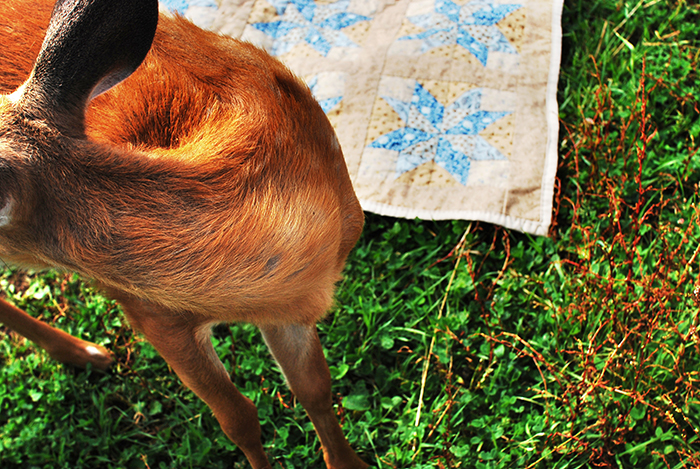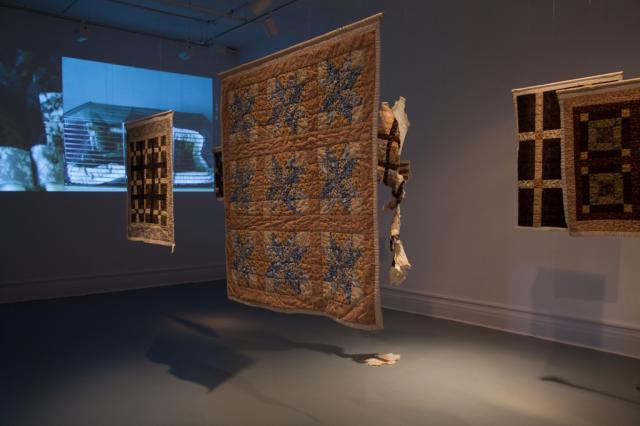
What does it mean to have a personal interaction with a wild animal? To what extent can humans intervene in the care and comfort of injured wildlife? Where is the line between person and beast? Is there really a dividing line at all? These are some of the queries that emerge from the den of Fleshold, D'Arcy Wilson's new fauna-filled show at La Centrale.
In wanting to explore how a gesture of human kindness might or might not translate to animals, the Halifax-based multidisciplinary artist set out to design and create a series of hand-made security blankets for in-patients at wildlife rehabilitation centres. Wilson documented the creation, delivery, and reception of her care quilts. The result is an exhibit marked with bursts of frenetic animal movement and methodical stitching motions—the labour-intensive handiwork of the quilts alone is dizzying. Though Wilson's video footage and photography bring the gallery to (wild)life, her drawings of empty kennels and cages introduce a pronounced stillness into the space. Likewise, there's a quiet tactility to the used blankets, an absence inherent to their presence. Nightlife.ca spoke with Wilson about animals and art, taxonomy and sympathy, and the gestural nature of her work.
Nightlife.ca: Can you talk a bit about your process of designing particular quilts for particular animals?
D'Arcy Wilson: Before I began each quilt, I knew which animal I was making it for. The first quilt was created for a fox cub at the Atlantic Wildlife Institute. I chose fabric that seemed appropriate for this animal—soft cotton patterned with wild flowers, blue sky, butterflies and texture that resembled fur. This process continued for the entire duration of the project; the skunk's quilt had dark shades of grey and black contrasted with cream-coloured fabric. The raccoon's quilt had tree boughs, berries, and stars printed on the fabric. As for the quilting, the stitches were completed each time in grids that recalled the architecture of the wildlife rehabilitation centres—the kennels, cages, and enclosures.
How did the employees of these centres engage with your work?
I worked with two wildlife rehabilitation centres, New Brunswick's Atlantic Wildlife Institute and Nova Scotia's Hope for Wildlife. The employees were ever so generous with their time and expertise, and they permitted me to visit the centres to hand deliver my quilts. They had a unique experience with the project that no one else could have had—myself included—in that they could watch the wildlife interacting with their quilts over a longer period of time. They would wash the blankets if they became soiled, and then returned them to the animals they were made for.
It would have been possible to take different avenues for your pieces—toys or objects of play, food or elements of sustenance. Why was it important that your interactions be based on comforting and nurturing?
It was essential to this project, as in my other works, that this gesture be one of nurturing and comfort. In all my work, I seek to have a positive role to play in nature, and in particular, one that is rooted with my place in the world as a female. Our relationship to the natural world in Canada has a rich and, at times, problematic history. Furthermore, this is mostly a male history of hunting, capture, colonialism, and seeing the natural world as a resource for the taking. In my work, I question whether or not as a female, I can have a different connection to nature—one that is rooted in stereotypical female roles as caregiver, nurturer, and mother. But, as is evident in this exhibition, these roles are also problematic, and my idea of nurturing does not necessarily translate for a wild animal.
Can you talk a bit about the relation of participant consent and authorship in Fleshold?
When I gave the quilts to the wildlife in the centres, they were enthralled with them—they smelled them, licked them, bit them, and dragged them out of view. At first I was shocked, and thought they actually liked them! But later I realized that my scent on the blankets was a major invasion of their space. Throughout this process, I strove to be respectful to the wildlife, careful not to commoditize them through my art piece; nevertheless, in the end this was perhaps unavoidable.

Photo: D'Arcy Wilson
Part of what influences our anthropomorphic attitudes towards certain animals is an often-tenuous sense of being able to connect with that animal, especially via the concept of species. The majority of the animals that appear in your work are mammals. How do you think your exhibit would have changed had you been working with reptiles or cephalopods, for example—classes of animals that are perhaps more difficult to relate to? How does the idea of species affect audience reception of your work?
The animals I chose to interact with were the animals that were present in the shelters—and thus, the animals that people encountered orphaned or injured in the wild and thought to rescue. I'm not sure that individuals in my community would give equal concern to a snake, a lizard, or even a mouse—maybe some would. The individuals who run the centres do not discriminate against the species of animals in their care—a pigeon is given the same consideration as an owl or a deer. I think this project, if ever repeated in a different location with a different wildlife habitat, would have a different range of living creatures involved. In some ways, this may be more successful—it is hard to escape the “cute” factor in this project, which can be a little distracting. I should also mention that the centres I worked with had many animals that I did not make quilts for. I focused primarily on the animals I thought would benefit the most from a blanket, which was determined in consultation with the organizations—most often these were mammals.
Fleshold
February 14–March 15
La Centrale | 4296 St. Laurent